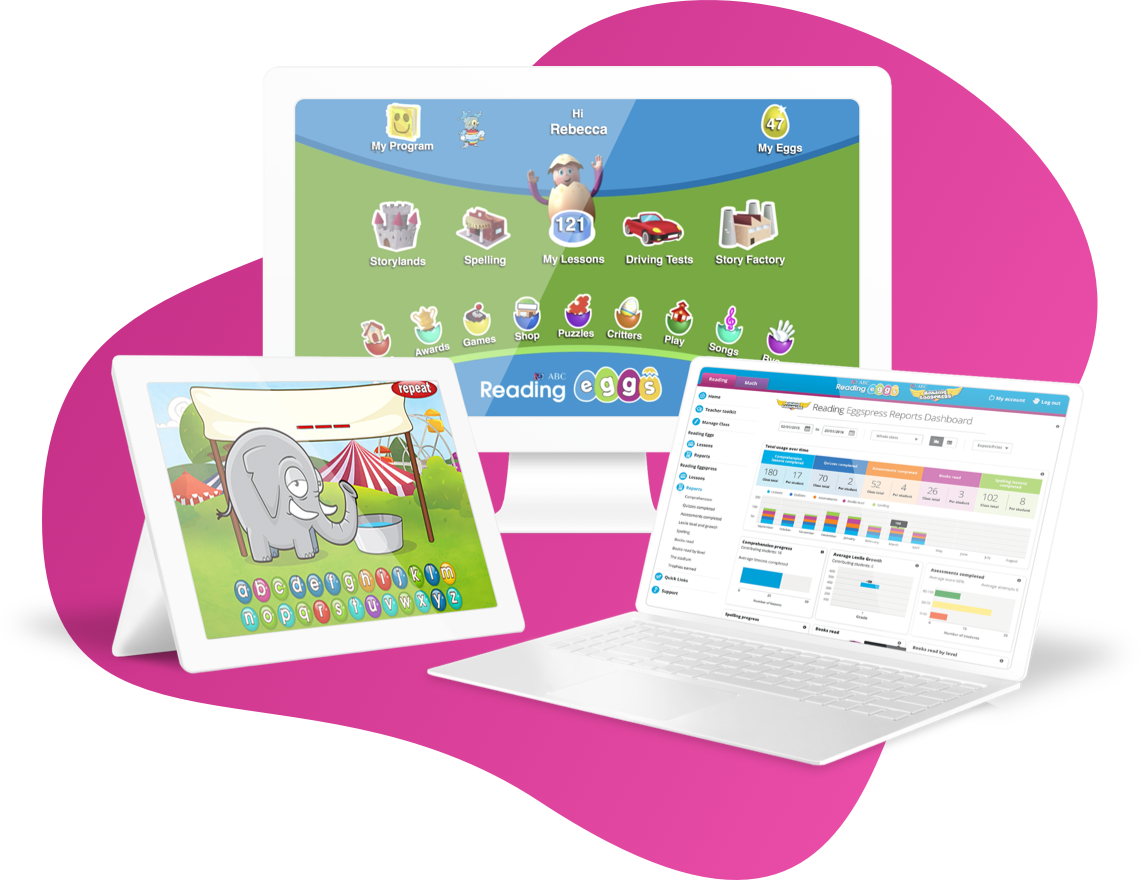Five Components of Reading Skills Fourth Grade

Reading skills are built on five separate components: phonics, phonemic awareness, vocabulary, fluency, and comprehension.
These components work together to create stiff, rich, and reliable reading abilities, but they're often taught separately or in uneven distribution.
Hither's how you comprehensively teach the 5 components of reading skills and make them a regular feature of your classroom.
Phonics
Phonics is the connection of different sounds with dissimilar messages, or different groupings of letters. For example, the alphabetic character 's' gives an /south/ sound, but calculation an 'h' gives the different audio of /sh/.
Why is phonics an important component of reading?
Phonics forms the nuts and bolts of the reading process. It allows students to connect arbitrary symbols on a folio to verbally expressed language. Fifty-fifty if a child has no understanding of what a word means , they will still be able to phonetically sound it out.
Phonics also develops students' ability to 'read by sight', i.e. register whole words at a glance without sounding out each individual letter. Even inside an unfamiliar discussion, students will be able to quickly sight-read phonic patterns (eastward.g. 'however' as a whole might be new, but 'how' and 'ever' will exist sight words).
Both of the above developments translate to reading fluency. Students are able to read much faster and more efficiently without having to stop and process the messages each fourth dimension they are confronted by a new slice of vocabulary.
iv ways to teach phonics for reading
There are different approaches to phonics instruction, just these activities will adjust whatever classroom.
- Rhyming games: Whatsoever activity that requires students to rhyme words will develop their phonic understanding. This might be writing a poem equally a class or mixing and matching pairs of rhymed words.
- Flexiwords: Have students intermission down a word into its private phonemes, each of which go onto a decorated piece of carte. Students then attach the phonemes (in social club) to an elastic band. Stretching out the ring will split the phonemes and helps students to view a tedious sounding out of the word. Relaxing it will reveal the word as information technology appears in regular speech.
- Phonics hopscotch: Draw hopscotch but substitute the numbers with graphemes (the letters representing phonetic sounds). Students take to jump between the different messages as they hear them from a instructor or partner.
- Estimate the word: Students write down a set of 5 words, then identify them in the middle of the tabular array. The teacher or nominated pupil then has to selection a give-and-take and give clues (east.yard. "it ends with -ig") while the others guess what information technology is.
- Word mix upwards: Put individual graphemes on split cards, and and then task students with manipulating them to create every bit many words equally possible.
Y'all can also download phonics teaching resources for free from our literacy hub.
Phonemic Awareness
Phonemic awareness is an agreement of how individual phonemes (consonant or vowel sounds) can be manipulated and arranged to create words. This may sound like to phonics, but there is a difference. Phonics concerns letter–sound knowledge, whereas phonemic awareness refers to sound–word knowledge. Phonemic awareness is therefore aimed on auditory agreement, equally opposed to words on a page.
Why is phonemic awareness an of import component of reading?
English language is written using an alphabetical arrangement, where every letter corresponds to an individual phoneme. This might sound obvious, simply it's not the case in other languages where characters stand for whole syllables (e.g. Japanese) or fifty-fifty whole words (every bit with certain Chinese characters).
This means that students need an sensation of phonemes themselves before they can make sense of words on a page. For case, to read the discussion 'true cat' aloud, students accept to know what the phonemes /c/, /a/, /t/ sound like when put together. And it'due south not easy either — phonemes have to overlap and catamenia together to class fluent speech.
For this reason, studies have identified phonemic awareness as the best early on indicator of a pupil's reading potential. It sets the stage for phonics, and virtually every other component of literacy.
5 ways to develop phonemic awareness for reading
- Phoneme isolation: Students place private phonemes in words, e.grand. "What is the starting time sound in 'boat'?" (/b/)
- Phoneme identity: Students identify the common sound in different words, e.g. "Tell me the sound that is the aforementioned in 'cycle', 'boy', and 'bell'." (/b/)
- Phoneme categories : students identify the give-and-take with the odd audio in a sequence, eastward.1000. "Which word does not belong? Bus, bun, carpet." (rug)
- Phoneme blending: Students mind to a sequence of separately spoken sounds and combine them to grade a recognizable discussion, e.g. "What word is /s/ /m/ /u/ /l/?" (schoolhouse)
Phoneme deletion : Students find the word that remains when a specified phoneme is removed, e.g. "What word practise we go when nosotros remove /due south/ from 'grinning'?" (mile)
Download printable literacy resource
Vocabulary
Vocabulary is the range of words a pupil is able to empathise and employ in context. More of a toolbox than a skill, students' vocabularies abound as they read and are introduced to new words.
Why is vocabulary an important component of reading?
You can just take meaning from words you understand. Students with broader vocabularies are more than confident when reading challenging or unfamiliar material. When they encounter unknown words, they tin figure it out based on context clues or resemblance to familiar pieces of vocabulary.
You tin grow students' vocabularies with regular reading in and out of the classroom.
5 ways to develop a stronger vocabulary for reading
- Word of the day: Create a daily roster for students to share a newly discovered or unusual word with the class. They could explain the word by providing an original definition, acting it out, or compiling a list of synonyms.
- Creative writing: Compile all the 'words of the day' gathered over the week and then task students with writing a story that uses equally many new words every bit possible. This ensures they larn how to use new vocabulary in context.
- Class glossary: When reading a text or studying a topic, compile a list of unfamiliar words, and assign them to students. Each student must create a glossary page with a definition, pronunciation guide, sentence instance, mnemonic (memory assist), and an image representing the word.
- Opposites attract: Assign each educatee a menu with a new discussion and its definition. They then take to find and pair upward with a classmate who has a give-and-take with the contrary significant.
- Vocab bookmarks: Have students design and create a bookmark with a space to write downward whatsoever new words they notice while they read. Laminate them so students can reuse them with a dry-erase marker.
Fluency
Fluency is the ability to read with speed, agreement, and accuracy. However information technology's more than than information extraction — it's the skill that allows u.s.a. to 'follow' a text, moving picture its descriptions, and hear the auditory expression of words in our heads even when reading silently.
Why is fluency an important component of reading?
Fluency is what lets students feel the 'menses' of a text. Struggling readers, for example, read aloud in a jerky, clipped fashion as if a new sentence begins with every word. Others might be oblivious to the shifting tone and pace of a text, reading information technology in a steady monotone with no expression. In both cases, the process of reading becomes painful and bad-mannered — fifty-fifty if students tin can successfully decode private words.
Fluency and comprehension are closely tied. A educatee cannot fully sympathize the meaning and ideas behind a text without the power to read it fluently.
v ways to develop reading fluency
- Teacher modeling : regularly reading aloud to students serves as a model for reading fluency. Exist expressive and vary your pace and then that students become a sense of the flow. If possible, have students read along with their own re-create of the text, so they can link it to the words they hear aloud.
- Phrase identification: Take a single sentence and read information technology aloud while students refer to the written version. Ask them to identify distinct phrases with an underline by listening advisedly to the pauses. Can they split the judgement into groups of words that run together? Model it offset to requite students a clear idea.
- Choral reading: Read a short text aloud to your students, and so take them read it aloud in unison. Matching the flow and pace of the grouping develops fluency.
- Paired reading: Having children read aloud to one another encourages them to develop the expression and flow needed for fluency. Pair students of unlike ability levels for more powerful learning, but make sure the disparity is not as well peachy.
- Apply audiobooks: Audiobooks paired with text permit students to link the words on the page with fluent and expressive reading. You can observe engaging audio titles in the Reading Eggs and Reading Eggspress Library, which contains over 2500 student eBooks.
Comprehension
Comprehension is a student'southward understanding of the data beingness imparted past a text, such equally:
- who
- what
- when
- where
- ideas
- meanings.
Why is comprehension an important component of reading?
Comprehension allows students to draw meaning and information from a text, and it also transforms reading from a purely functional activeness into 1 that inspires thought and feeling.
five ways to develop comprehension skills for reading
- Drawing: Ask your students to draw or paint a scene from a written text. This encourages them to imagine the concrete details being represented by the words themselves.
- Questioning: Follow upward reading time with open-concluded questions that prompt students to remember deeply virtually the text. For example, if reading a narrative, you might ask students how a graphic symbol inverse over the form of a story, or how a central problem influenced the action.
- Encourage reflection: Ask students for their opinions on the text in order to encourage deeper reflective thinking about the ideas. For example, you might inquire what emotions were evoked by a setting, or whether a grapheme'south actions were right or wrong.
- Make connections: Encourage students to make connections to their own lives and other texts that they take read. Weave this into your discussion or questioning after reading in order to link comprehension with real-world concepts your students tin relate to.
- Make reading a habit: The more than students read, the more confident and astute their comprehension skills will become.
Addiction is fundamental for all reading skills!
Remember: the best affair yous can practice to aid children become confident, fluent readers is to put them in front end of as much written material as possible. Make it a regular and celebrated part of your classroom action, and you'll gear up them up to go readers for life.

Boost early on learners' reading skills with Reading Eggs.
Source: https://www.3plearning.com/blog/reading-proficiency-with-5-essential-components-of-literacy/
0 Response to "Five Components of Reading Skills Fourth Grade"
Post a Comment